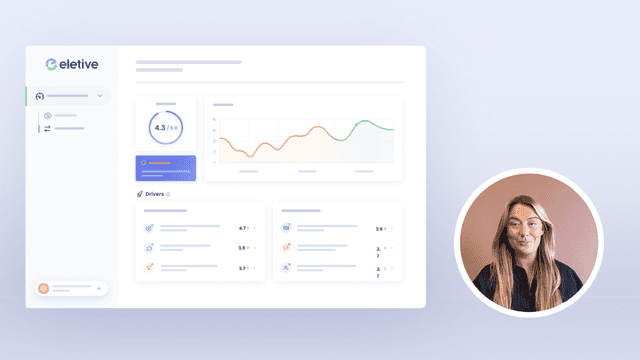As competition for top talent is growing increasingly fierce, companies are putting more and more resources toward employer branding. This is very understandable, considering that the ability to hire the right people is critical to the success of any business.
Ever thought about how giants like Google or Apple attract top talent? What makes them irresistible to job seekers?
Picture your company as a magnet. It’s not just any magnet, but one that draws in the best of the best. The secret lies within your company's core – it's the 'employer brand'.
You see, an employer branding strategy is more than fancy words and shiny perks. It's a promise. A commitment.
A strong employer brand can work wonders - from boosting company culture to attracting premium talent and even reducing hiring costs.
But getting there isn’t easy…
Join us as we delve deeper. We'll discover what makes companies stand out, how to forge a powerful strategy for your business, glean lessons from their triumphs (and setbacks), and show you how to sidestep common pitfalls.
What is an employer branding strategy?
An employer branding strategy, put simply, is the way a company markets itself to job seekers and existing employees.
It's not just about the logo or catchy slogan but extends more into how an organisation treats its people and what it stands for.
This goes beyond your corporate brand; while that might be focused on attracting customers, employer branding targets potential and current employees. The goal?
To make sure you're seen as a great place to work. According to Forbes “a strong employer brand results in a 28% reduction in turnover and a 50% reduction in cost per hire”.
The role of company culture in employer branding
A major part of your employer brand hinges on company culture - think Google's famous 'fun' workplaces or Apple's innovative spirit (we’ll cover these in more detail later on).
This means things like working conditions, benefits packages, training opportunities are all key elements in defining your brand.
In essence: if corporate branding tells people why they should buy from you, then employer branding shows them why they should work for you. They're two aspects of the same thing – both vitally important but targeted at distinct groups.
Benefits of an employer branding strategy
Attract top talent: A strong employer brand attracts quality candidates, making recruitment easier. You're not just another company; you're the place everyone wants to work at.
Better retention rates: When employees are proud of where they work, they’re more likely to stick around. That means lower turnover and fewer resources spent on hiring.
Increase employee engagement: Your team members will be more invested in their roles if they feel part of something bigger than themselves. This is key for boosting productivity and fostering innovation.
Cultivate company culture: A solid employer brand helps cultivate a positive workplace culture that reflects your values as a company – it’s about walking the talk.
Elevate corporate reputation: Your reputation as an employer directly impacts how people view you as a business overall. In other words, good employers make great brands.
Promote growth: By attracting better talent and increasing employee engagement, you'll see improved performance across all levels which promotes growth in every aspect.
Social media reach: A powerful tool like social media gives employees (and potential employees) a chance to share their positive experiences. This can significantly extend your reach and impact.
Competitive advantage: Having a strong employer brand sets you apart from competitors, giving you an edge in the fierce battle for top talent.
Increase bottom line: A top-notch employer branding strategy doesn't just give a hand with recruitment. It also significantly boosts your bottom line.
Employer branding strategy examples
We'll now explore some top-tier employer branding strategies, specifically from Google, Apple and Microsoft. These tech titans have perfected the craft of luring and preserving top-notch employees.
Apple employer branding strategy
Apple's employer brand reflects its product brand - exclusive, innovative and aesthetically pleasing. They've cultivated a sense of mystery around what it's like to work there which creates intrigue amongst potential candidates.
In addition to this allure of exclusivity, Apple focuses on hiring those who align with their values of innovation and attention-to-detail.
This focus ensures employees feel part of something bigger than themselves; contributing towards industry-changing products.
Croisette
Croisette Real Estate Partners, a Swedish advisory firm, aims to bolster its employer brand and attract top talent as part of its expansion strategy.
They used Eletive to measure their employer brand strength. How?
By employing the Employee Net Promoter Score (eNPS), which assesses employees' willingness to recommend the company to others.
From this, they discovered that their employees are content and enthusiastic about endorsing the company as an employer, indicative of a robust employer brand. Eletive further enables continuous monitoring and immediate feedback to maintain this.
Croisette's decentralised organisation values self-leadership and self-reflection among employees, granting them autonomy in shaping their roles. Eletive empowers individual employees by offering access to their survey results, fostering accountability, and creating a culture of constant feedback.
Our platform's collaborative nature also encourages employees and managers to work together in building a culture that enhances well-being and performance.
Rutgers
Rutgers, an NGO based in the Netherlands, has effectively integrated Eletive into its employer branding strategy to create a happier and healthier workplace for its 130 employees.
Through real-time pulse surveys and transparent communication, Rutgers has taken steps to enhance its brand image as an organisation committed to employee well-being and engagement.
Geert Jan, the HR manager, recognised the limitations of traditional annual surveys and sought a more dynamic approach. With the intention of positioning Rutgers as forward-thinking and employee-centric.
The organisation's commitment to swift action on feedback not only improves workplace culture but also reinforces their reputation as an institution that values and supports its employees, strengthening its employer brand in the process.

Microsoft employer branding strategy
An integral part of Microsoft’s employment appeal lies in their commitment towards diversity inclusion efforts along with personal growth opportunities for every employee irrespective of where they stand in the organisational hierarchy.
They prioritise employee development, with numerous opportunities for learning and advancement.
This not only attracts ambitious individuals but also aids retention as employees feel valued and invested in.
Google employer branding strategy
Google's reputation as an innovative powerhouse is no accident. Their approach to employer branding highlights their commitment to creating an environment that fosters creativity.
Their strategy emphasises benefits like free meals, on-site wellness services, and flexible work schedules.
But it’s not just about perks - Google makes sure they attract individuals who are passionate about making a difference in the world through technology.
Employer branding strategy template
An employer branding strategy is like a roadmap, guiding you towards your goal of becoming an attractive and sought-after place to work. Here’s a template to help you build it…
Step 1: Define your employer value proposition (EVP)
Your EVP serves as the heart of your employer brand.
It encapsulates why people should want to work for you over others in the market. SHRM suggests that it needs to be authentic, distinct and consistent across all touchpoints.
Identifying your unique offer
To create a compelling EVP, start by understanding what makes your company special.
Consider asking current employees why they chose to join and stay with your team by utilising open ended questions - their answers may surprise you.
This exercise will help reveal some hidden gems that can become key elements in your value proposition. But remember not all feedback will be positive – use this opportunity to also identify areas where improvement is needed.
Making your promise credible
A strong EVP must ring true – empty promises won’t cut it. You need concrete examples showing how you live up to each element of your promise.
These could be case studies showcasing employee growth or testimonials from staff who have benefited from specific initiatives.
Communicating your EVP effectively
Telling potential candidates about your brilliant offer isn't enough; we've got to show them too. That’s where the Employee Experience comes into play: from recruitment ads through the onboarding process right up until exit interviews.
Showcase real stories behind these experiences across multiple channels such as social media platforms, company websites or even at job fairs.
Ensure consistency in messaging – your EVP should echo throughout all communications and interactions. It's not only the words you use, but your conduct that matters.
Now you have a solid EVP, you’ll need to live up to that as much as possible.
Step 2: Use employee surveys and eNPS scores to monitor progress
Use engagement surveys to monitor the employee experience and track your eNPS (employee net promoter score).
This way, you can ensure things are moving in the right direction.

Make sure your surveys cover all important drivers behind employee engagement — such as workload, autonomy, communication and feedback, and employees' relationships with their managers — and make sure you have a structure for follow-up questions.
Step 3: Involve and empower everyone to help drive positive change
It's crucial to involve the whole organisation and empower all your employees to take part in driving change.
By making individual survey results available to each employee, you enable self-leadership and accountability.
Managers can use the survey results to create action plans together with their teams.
By fostering an inclusive and collaborative approach, you take some pressure off HR and managers and create a dynamic where everyone cooperates to build a better workplace.
Step 4: Track progress, stay agile, and iterate along the way
Employee engagement and your employer brand are living, breathing things that will change and evolve. They're not something you can set and forget; they should always be on the agenda.
That's why agile pulse surveys are a better tool for improving engagement than annual surveys.
It's essential to be agile and work proactively. This means different things in different organisations, but some things apply everywhere. The need for regular feedback, one-to-ones, and clear communication around goals and expectations is universal and an essential part of increasin
Eletive has a pulse survey feature you can implement in less than a month >> More information here.
How to improve your employer branding strategy
Strengthening your employer branding strategy isn't just a one-time project, it's an ongoing process that needs regular attention and adjustment.
So let's look at some effective ways you can enhance your approach:
Boost employee engagement
Building a solid employer brand is done by looking under the hood to see how things are actually working.
Are people happy and fulfilled? Do they get recognition for their hard work? Do they feel a sense of belonging? A sense of purpose and alignment with your company values?
If they do, congratulations! Then you really won't have to do all that much, except provide your people with the tools and channels to tell the world – because they will happily do so.
But if not, it's time to take action.
Strong employer brands are built on authenticity and transparency. So, how will you know what's under that hood? The best way is to ask your employees — regularly and in a structured way.
Not just once a year, but continuously.

That way, you will know what is working and where there's room for improvement. And you can be proactive, iterate and build a thriving workplace — together.
Tell your story
Your company has its own unique story – tell it. Make sure this narrative shines through all aspects of your brand - from job ads to onboarding programs.
The story should reflect what makes you different as an employer, such as your mission or values. This will help potential candidates understand if they’re aligned with these principles too.
Maintain consistent messaging across channels
You may have various platforms where you communicate with current staff and prospective hires: LinkedIn page, website careers section or even Glassdoor reviews.
All these channels should convey consistent messages so there is no confusion regarding what kind of employer you are.
Measure the success of your employer branding strategy
To know if your employer branding strategy is working, you need to track key metrics. This helps determine whether your efforts are successful, or if adjustments are needed.
Here are a few things you can track
Application numbers and quality
Employee Turnover: Low turnover indicates strong employee engagement
Employee Satisfaction: Engaged employees tend to be more satisfied. Regular pulse surveys provide insights for improvements in real time.
Social Media Engagement: Analyse metrics like shares, comments, and likes to gauge your brand's appeal.
Offer Acceptance: Frequent job offer acceptance signals an attractive brand.
The role of leadership in employer branding
Leadership plays a vital role in shaping and implementing an effective employer branding strategy. Their influence goes beyond setting the tone; they embody the brand's values, making them crucial to its success.
Leading by example
A company's leadership sets the bar for what is expected within an organisation. They exemplify the behaviours that align with their company culture and core values. By doing so, leaders become living examples of what it means to be part of their team.
In fact, research from Gallup suggests that managers account for at least 70% variance in employee engagement scores across business units. This demonstrates just how much sway a leader can have on team morale and commitment.
Crafting a compelling vision
An effective leader also has a clear vision for where they want to take their company – and this includes its reputation as an employer. The best leaders not only craft this vision but inspire others to buy into it too.
When staff have faith in their leader's vision, they are more likely to be content with their employment, practice self leadership, and display enhanced performance.
Eletive give you the tools you need to empower your workforce and build a culture of accountability, inclusion, and high performance.
Influencing employer brand perception
The actions of a company’s leadership directly influence how current and prospective employees perceive its employer brand.
For instance, leaders who consistently demonstrate empathy and inclusivity can foster an environment where people feel valued and respected.
Employer branding best practices
Your employer brand is not just a symbol, but rather the total of how your organisation deals with its staff and how they showcase you to the world. Here are some top-notch practices that can help make sure your branding stays strong.
1. Be authentic
An authentic brand appeals not only to potential recruits but also helps retain existing talent. Keep things real by sharing true stories from within your team – triumphs as well as challenges.
2. Employee advocacy matters
The most effective marketing tool at any company’s disposal? Its people. When staff genuinely love their work and speak positively about their experience, it sends out a powerful message about your culture and values.
3. Transparency is key
To be transparent doesn't mean revealing every detail - instead, it involves open communication between leadership and staff regarding business operations or changes on the horizon.
Anonymity helps people be honest. Tools like Eletive give a safe way for employees to share their thoughts without worrying about getting into trouble.
The main goal?
To make a workplace where everyone can talk openly, from the big bosses to the regular workers. This is all about building trust, making good decisions, and making your company better with information from the people who work there.
Aligning with company values
A consistent set of core values provides direction for all aspects of an organisation - including recruitment, performance reviews, rewards schemes etc., creating unity among diverse teams.
Mistakes to avoid in employer branding
Building a strong employer brand is like climbing a mountain.
Failing to be adequately prepared for the ascent can prove perilous. To ensure a successful ascent, let's examine potential pitfalls and how to avoid them.
Ignoring employee input
The first pitfall lies in overlooking employee input. Employees are your most important stakeholders when it comes to employer branding because they live your brand every day. Gallup suggests that companies with high levels of employee engagement outperform their peers by 147% in earnings per share.
Your team knows what makes working at your company unique better than anyone else. So, ask for their opinions and incorporate them into your strategy.
Lack of consistency
The second hurdle is inconsistency across different channels or departments within an organisation. An inconsistent message confuses potential employees about who you really are as an employer.
To avoid confusion, ensure all communications from job descriptions to social media posts align with your overall employer value proposition (EVP).
Neglecting your online presence
The third misstep could be neglecting the digital aspect of branding – particularly online reviews on platforms like Glassdoor or Indeed. According to SHRM, 83% of job seekers research company reviews and ratings when deciding on where to apply for a job.
Responding promptly to negative reviews and celebrating positive ones is an effective way to manage your online reputation. This demonstrates that you value feedback and are committed to improving the employee experience.
Build a culture where people thrive with Eletive
Strong employer brands facilitate both recruitment and retention. And a strong employer brand equals a workplace where people love to work. The better you understand your employees — what they like, what they need, and what brings out their best — the easier it will be to create that workplace.
By building a culture of safe communication and feedback, you're paving the way for people's success. And when your people succeed, so will your organisation.
Get started with Eletive here.
FAQ
What is employer branding?
Employer branding is a strategy used by companies to attract and retain top talent. It is based on the idea that by creating a positive image of the company as an employer, it will be more attractive to potential employees.
What are the benefits of employer branding?
Employer branding can help companies to attract and retain top talent, build a positive reputation, and increase employee engagement and motivation. It can also help to create a competitive advantage in the job market.
How can companies build a strong employer brand?
Companies can build a strong employer brand by focusing on employee engagement, creating a culture of inclusion and trust, and using surveys and eNPS scores to monitor progress.
What is the importance of employee engagement in employer branding?
Employee engagement is essential for a successful employer branding strategy. If employees are happy and fulfilled, they will be more likely to share positive stories about their employer, which can help to attract top talent.
What are some steps companies can take to build a strong employer brand?
Companies can build a strong employer brand by using employee surveys and eNPS scores to monitor progress, involving and empowering everyone to help drive positive change, and tracking progress, staying agile, and iterating along the way.
What are the 3 components of employer branding?
The three key parts of employer branding include defining your Employer Value Proposition (EVP), showcasing it effectively, and consistently delivering on its promises.
What are the 5 dimensions of employer branding?
The five dimensions typically cover economic value, development value, social value, interest value and application value. They form a holistic view of what makes your brand attractive to potential employees.
How do you build a successful employer branding strategy?
To create a successful strategy, start by understanding employee needs. Then define an appealing EVP. Consistently communicate this through various channels while continuously gathering feedback for improvement.

























